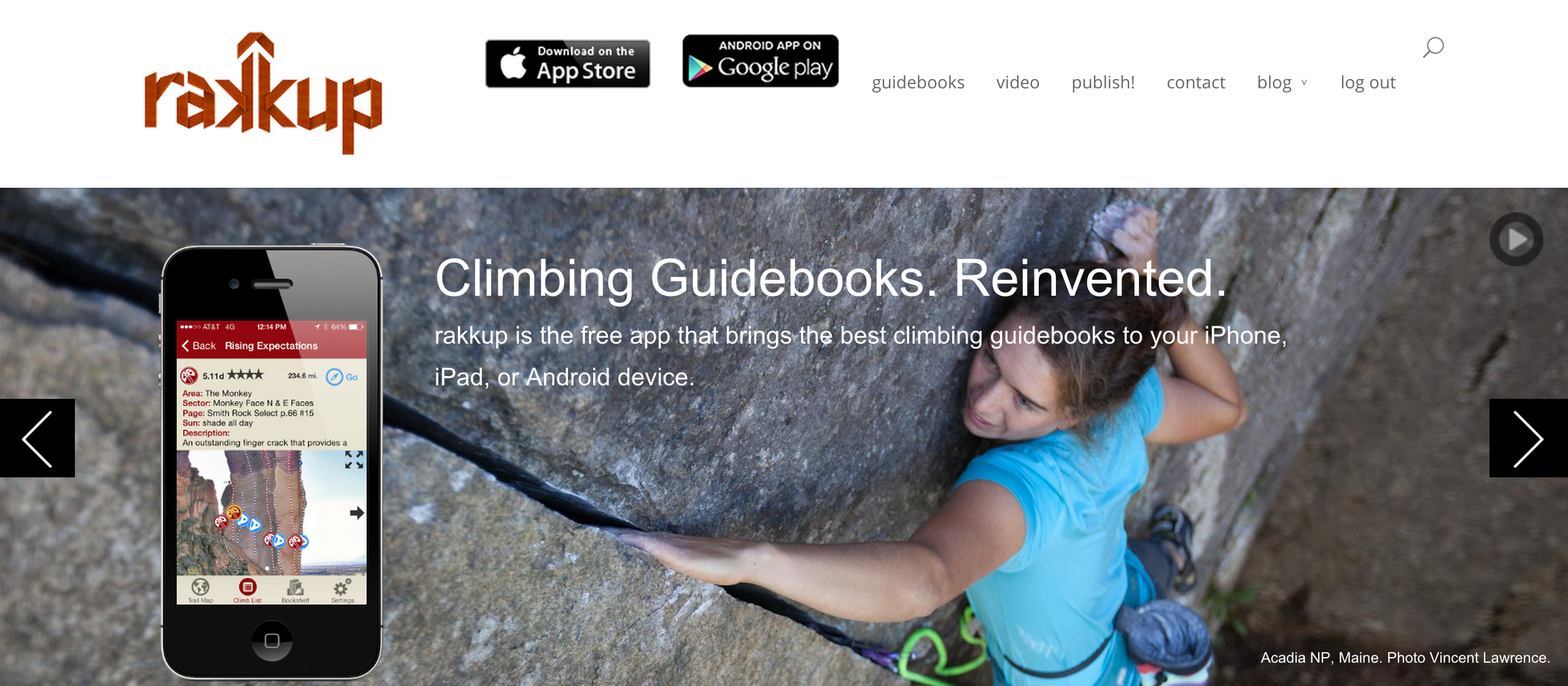by todd | Oct 16, 2015 | Uncategorized
Buy or rent
Carderock here and save money versus purchasing from within our app via Apple or Google. It’s exactly the same guidebook, but offered at a lower price on
rakkup.com.
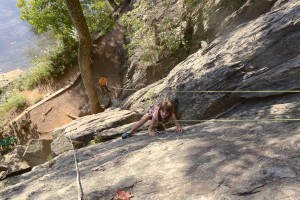
Erica Braun on The Laundry Chute (5.7).
Carderock has been Washington, DC’s favorite escape for rock climbers for almost a hundred years, for good reason. Conveniently nestled at the edge of residential Washington, DC and overlooking the Potomac River, it’s a perfect stop for climbers looking for a quick fix before heading home for dinner. Because the crags are less than a hundred yards from the parking lot, and the Billy Goat C trail runs through the crag, access to the top and the bottom is quick and easy. It’s no surprise that Carderock is busy every night during the summer with campers, climbing classes, and regulars.
There is a pervasive myth that Carderock is a beginner’s crag. This myth probably took hold because of the presence of families with young children scrambling on the rocks. The locals know that the climbs are heavily sandbagged, rated by hardcore climbers decades ago before quartz holds broke off and the schist wore down to a smooth polish, turning Carderock into “the grease of the East.” In reality, Carderock has a breadth of difficulties. It has easy laybacks and fun chimneys for beginners. But, it also has many of the most difficult friction slab routes on the East Coast. Chris Sharma, arguably the best climber in the world, fell repeatedly on Evan’s Bolt Ladder (5.12d) during a televised National Public Radio interview. We have tried to address the pervasive sandbagging in our guidebook by re-rating some climbs as objectively as we could; this results in some surprising differences between our ratings and those historically known. Let us know what you think!
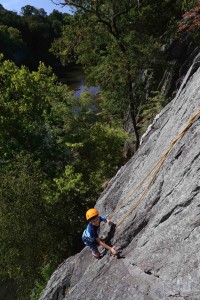
Carter Braun at the top of Trudie’s Terror (5.8)
The rock is a mica schist with quartz knobs arising from the Wissahickon bedrock formation. The schist is slick during the humid summers. Shoes stick best during the spring and fall when the air is brisk and dry. Because the schist is slick and friable, protection can slip out or break out easily. Therefore, lead climbing is not recommended at Carderock, and all its routes are top-roped and usually tied into trees or boulders.
To get started climbing at Carderock, you only need minimal equipment. If you’ve never climbed outdoors before, we strongly recommend taking a climbing class offered by Earth Treks, REI, or a local guide, because almost all accidents at Carderock have happened with inexperienced climbers. We recommend a 40 meter dynamic climbing rope, 30-40 meters of burly static line, and at least two additional locking carabiners. If you can manage to rock a pair of Carhartt’s double-duck pants and tie your anchors using bowline hitches, you’ll blend in with the old-school locals.
In our guidebook, we touch on Carderock’s storied history. It was the site of some of the earliest technical climbing in North America, dating to the 1920s. Herbie’s Horror, one of the first 5.9 routes in North America, is at Carderock. Herbie’s wife, Jan Conn, went on to participate in the first all-female ascent of Devil’s Tower, Wyoming. The Conns named climbs at Seneca Rocks, in New Hampshire, and out west. Many accomplished climbers and mountaineers climbed here who went on to first ascents at prominent peaks in the Tetons, Denali, and elsewhere. Noel Odell, who was the last person to see George Leigh Mallory alive on Everest in 1924, is said to have climbed at Carderock.
Today, Carderock is a section of the Chesapeake & Ohio Canal National Historical Park. Its continued conservation is because of the efforts of the Mountaineering Section of the Potomac Appalachian Trail Club (PATC-MS) and dedicated local climbers like John Forrest Gregory, the ‘mayor of Carderock.’
In creating our guidebook, we tried to make it comprehensive and easy to use. We include the main walls at Carderock but also less climbed areas, including Outlook Rocks, Easter Egg Rocks, Jam Box, and Vaso Island. We’ve also included photos showing you where to place your top-rope anchors, since climbs look much different looking down than they do when you’re looking up from the bottom. We hope that our guidebook helps you find the challenge you seek and that it adds enjoyment to your day. We’re going to keep working on our guidebook until we feel that all our photographs are perfectly clear and our beta is rock solid, even if this takes us years. And, if you see us around at Carderock and recognize us, don’t be a stranger – say hello!
Climb on!
by todd | Apr 24, 2015 | Uncategorized, World's Best Rock Climbing Areas
Buy
Foster Falls here and save money versus purchasing from within our app via Apple or Google. It’s exactly the same guidebook, but offered at a lower price on
rakkup.com.
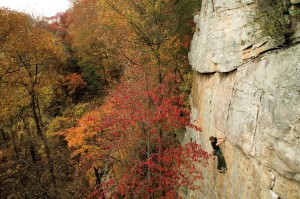
Jason Reynolds on Atrophy (5.11b)
Some of the earliest Foster Falls rock climbing activity dates back to the mid-80s to a handful of now forgotten or retrobolted routes established by a crew of traditional climbers including Chattanooga locals and visiting climbers like Rob Robinson, Steve Goins, and Hidetaka Suzuki. Limited by the amount of ground-up features and paths present within the largely overhung and blocky cliff, these climbers soon moved on to cliffs more palatable to their preferred style.
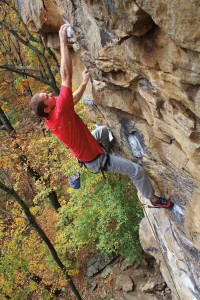
Jay Perry on Thieves (5.12a)
This fact left Foster Falls wide open for the wide-scale sport climbing development that was soon to follow in the early 90s. Led by the efforts of Eddie Whittemore, a bulk of the hardest and best routes at Fosters quickly fell to a committed group of climbers including Southern notables like Doug Reed, Porter Jarrard, and Chris Chestnutt. Other climbers like Paul Sloan, Steve Deweese, Louie Rumanes, and Chris Watford added to the route inventory throughout the mid-90s, while hardmen like Jerry Roberts established new high-end lines in the steep Bunkers.
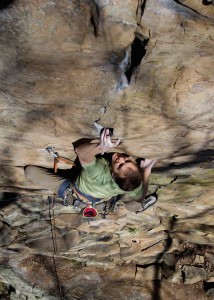
Mike Moore on Super Saturated (5.10c)
Meanwhile, the largely unsung hero of Foster Falls moderates, Steve Jones, began bolting some of the most popular routes at Fosters dating back to the early days of development and continued to do so right up until the recent past. His efforts have led to the growing popularity of far-end moderate walls that are still being filled out by Nashville locals like Mike Moore and Darryl Bornhop. With the exception of a few obscure areas, the walls at Foster Falls are largely tapped out and are home to some of the most well-traveled and well-loved routes in the Chattanooga region. Of special note, with the help of the Southeastern Climbers Coalition, the cliff we climb on (once privately owned), has been secured and turned over to be managed by the South Cumberland State Park guaranteeing future access to this valuable climbing resource.
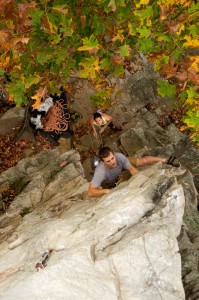
Richard Parks on Bear Mountain Picnic (5.8)
Foster Falls rock climbing is located in the hills of Jasper Tn, After leaving I-24, go north on 28 and get off at the Jasper exit (sign for Foster Falls), and head left off the exit ramp onto Main Street (West 72). After passing through the town of Jasper, take a right at signs reading TN150/US41 north toward Tracy City. Stay on TN150/ US41 North as it splits left and heads up the mountain. The entrance to Foster Falls (marked by a sign) is on your left 6.5 miles up the mountain from this split.
by todd | Mar 19, 2015 | Uncategorized

Now you can follow us on our rakkup Pinterest page, a new visual way to hear rakkup content news. Browse our climbing guidebook catalogue, read about why our guidebook authors believe their local climbing areas are awesome, or stay updated whenever we publish guidebook content updates.
by rob | Nov 9, 2014 | Uncategorized
Todd and I woke up to the sad news of the passing of Dave Pegg this morning. We still don’t know much but we’re saddened and took time to share memories with each other today.
Dave was the energy and the soul of Wolverine Publishing, and probably did more to raise the standard for North American climbing guidebooks than anyone in memory. The work he did helped thousands of climbers have happier climbing days and influenced many other authors who told us straight up that Wolverine’s work set the bar for them.
Todd and I met Dave and Fiona less than two years ago at their home near Rifle, when rakkup was in its infancy. They were among the very first to believe in us and put their trust in us, and Dave was a great partner to work with. He was honest and conducted his work with integrity, and he did what he said he would do. This is a rarer quality than some might think, and we valued it. He had vision for the future but tempered with the practicality he needed to make the present work.
But beyond that, we had a great admiration for Dave because he made time to do the things he loved, most especially climbing, and always seemed to be in the places and around the people he loved most, with a smile on his face. He worked hard and played just as hard.
Wolverine was pretty much the first to have apps for their guidebooks, way ahead of their time. We jumped at the chance to meet and earn the opportunity to build on the incredible library Wolverine had accumulated. Todd and I drove across the state of Colorado for a meeting and in the process got to enjoy hospitality and make new friends. On a later visit, we got to visit Dave’s new somewhat secret new crag and watch him work on his project of the day. He was clearly in his element and it was a beautiful thing to watch.
We will miss him and share condolences with all who feel this loss. If there’s anything we can to do preserve and build on the legacy that Dave created, we will give it our all as he would have.
-Todd and Rob
by rob | Jul 10, 2014 | Uncategorized
We’re proud to say we’ve launched a beautiful new website here at www.rakkup.com! Thanks to those who worked so hard on it and the amazing photographers who shared their work with us. Which image on our home page gets you stoked the most? Is there anything else you’d like to see?












